Read All About Persian Illuminated Manuscript
Illumination Manuscript, known as “Tazhib” in Persian, is a famous art in Iran. It has been used for many years to decorate buildings, books, works of art, and various objects. The fine details of this art have made it popular in industries such as printing and packaging. Some people think illumination is part of Persian miniature painting. However, its unique features have made it a separate art form over time. Iran has a long history and many great artists. Many Iranian artworks and handicrafts come from these artists.
If you want to learn about traditional Iranian arts and Illumination, read on. We will talk about the art of illumination, its uses, its different styles, and how it is different from miniature painting.
What is the Art of Illumination Manuscript?
The word “Tazhib” means “gilding” or “covering with gold,” and it comes from the Arabic word (ذَهَب) which means gold. The art of illumination includes designing, coloring, and gilding various motifs with geometric and plant motifs. These decorations are used to beautify the margins of handwritten books. These books include the Quran, religious texts, cultural and historical books, and collections of poetry. Illumination is a branch of Iranian miniature painting. An artist who deals with this art is called a “Mozheb.”
Types of Illumination Manuscript
Illumination is one of the most delicate Iranian arts and is a subset of visual arts. The designs are generally divided into three main patterns:
- Islamic Patterns (Naghsh-e Eslami)
- Khatayi Patterns (Naghsh-e Khatayi)
- Tashir Patterns (Naghsh-e Tashir)
Islamic Patterns
Islamic patterns use geometric and regular shapes for illumination designs. These motifs often include Kufic script and are referred to as Islamic designs.
Khatayi Patterns
Khatayi patterns have interconnected flowers with intertwined stems and leaves. This type of illumination is often seen in the tile work of mosque entrances and historical monuments. Khatayi illumination became popular and reached its peak in the 12th century.
Tashir Patterns
Tashir patterns combine Islamic and Khatayi designs. This style often includes images of birds, animals, humans, and nature. Some designs also have mythical creatures. Tashir is also known as “Royanegari,” with famous designs, including animal fighting scenes. Tashir illumination is usually used in book designs, but animal motifs are not used in Quranic designs.
The dominant color in the Tashir style is gold. Other styles use a variety of colors derived from plants, minerals, and chemicals. Plant-based colors come from natural extracts such as walnut skin, tea, henna, and gum Arabic. Mineral colors are made from gold and other metals like silver, tin, lead, and copper. Different metal oxides create different colors. Chemical colors include oil paints, gouache, and watercolors.
Applications of Illumination Manuscript
Illumination has many branches, each used for different purposes. Some of the most famous uses of this art include:
Margin Illumination
Margin illumination involves the use of decorative patterns to frame pages of books, panels, or photos. This type is often used to decorate the Qurans, poetry collections, and historical books.
The designs in margin illumination are very detailed, and the colors are chosen to complement the text or image. This branch is also widely used in the printing industry.
Decorating Calligraphy and Large Panels
In this method, different parts of the panel and spaces between letters and words are decorated to enhance the visual appeal of the calligraphy. It often includes floral, plant, and animal motifs. Many decorative panels are appreciated by art lovers in this category.
Designing Textile Patterns
Illumination artists create various geometric, floral, and animal designs for carpets, rugs, lovers, and other textiles. Wall painting is another application used to beautify traditional and historical spaces.
Tile Design and Restoration of Historical Works
One of the most common uses of illumination is tile design for buildings and restoring historical monuments. Despite advancements in architectural designs and new styles, traditional motifs are still popular in construction.
Printing and Packaging Industry
Different branches of illumination are used in the printing and packaging industry. For example, we can mention postcards and certificates of appreciation. Many shops sell illuminated works, and there are technical schools and vocational training programs that teach different branches of illumination. Many students study these subjects and find work in various market sectors.
Schools of Illumination
The art of illumination has different schools, which are divided according to historical periods. The styles and methods of illumination artists in various historical periods caused changes in their artworks. Each school of illumination is named after the ruling dynasty of its time and includes various sub-branches.
These schools reflect the characteristics and states of the governments and artists of different historical periods. For example, artworks from the 10th century CE are known for their simplicity, while works from the 11th and 12th centuries CE are more cohesive. In the 13th and 14th centuries CE, illumination art became more luxurious and splendid. In the next two centuries, the 15th and 16th centuries CE, the art moved towards simplicity, delicacy, and increased elegance. Each historical period brought its own unique style to the art of illumination, which was influenced by the cultural, political, and social contexts of that time.
The different schools of illumination and their sub-branches are distinguished by diversity in designs, colors, patterns, and the arrangement of lines. For example, the Bukhara sub-branch of the Seljuk school commonly used dark and bold colors. The main schools of illumination are as follows:
Seljuk School
The most important feature of the Seljuk school of illumination is the use of Khatayi patterns instead of geometric lines. This style was widely used in religious books during this period and led to a shift from simple Kufic script to decorative Kufic, Thuluth, and Raqqa scripts.
Ilkhanid School (Tabriz)
During the Ilkhanid period, Tabriz was the capital and the main center for creating artworks in Iran. The kings and ministers of the Ilkhanid dynasty were great patrons of artists and the arts, leading to a flourishing of illumination. This school is also known as the “Tabriz School,” with many notable works remaining from Ilkhanid artists in this city. The Ilkhanid school is characterized by angular designs in illuminated works.
Ilkhanid period’s illumination has diverse star-shaped designs, such as eight-pointed and twelve-pointed stars in blue. The background of works from this period is often lapis lazuli, with large motifs. Manuscripts from the Ilkhanid period were written in broad Kufic script.
Timurid School (Herat and Shiraz)
The Timurid era is considered the peak period for the art of illumination. Sultan Baysunghur, one of the most famous Timurid rulers, had a great passion for illumination, calligraphy, and miniature painting and was skilled in these arts himself. He established a large library in Herat, where many artists began creating their works.
Timurid or Harat school illumination is known for its delicate and intricate decorations. Illuminators of this period used motifs of plants, nature, and birds in their designs. The most beautiful examples of Timurid illumination are religious texts and Qurans dedicated to Timurid kings, including Sultan Baysunghur. Gold and lapis lazuli were extensively used, and the Tashir style emerged during this period. The Shiraz, Tabriz, and Khorasan branches are sub-schools of the Timurid school.
Safavid School
During the Safavid period, illumination art remained at its peak. The Safavid school is known for designing the first, middle, and last pages of historical and religious books with Islamic patterns, Shamsa (sunburst), and Toranj (medallion) motifs. Bejeweling, or “Morssa,” was also introduced in Safavid illuminated works. In Arabic, “Morssa” means “decorated with jewels.”
The Safavid school is famous for designing the first, middle, and last pages of historical and religious books with Islamic motifs, Shamseh, and Tanraj. Bejol or Mursa is also introduced in Safavid’s gilded works. Mursa in Arabic means decorated with jewels.
Safavid illumination is characterized by blue backgrounds with prominent gold and silver motifs and the use of green, white, blue, and red inside decorations. Books from this period were written in Nasta’liq script, and some Qurans were decorated with gold.
Qajar School
In the Qajar period, the art of illumination did not have the same splendor as in previous eras, but around 50 exquisite works from this period remain. These artworks are now housed in museums such as Reza Abbasi, Malek, Parliament, and Golestan Palace. Most examples of Qajar illumination are found on the first and last pages of religious books, with some interesting decorations in the middle pages.
Qajar illumination is notable for its use of fine, orderly textures created with a needle in the gilding of artworks, a technique known as “Sanajaqneshan.”
Final Word
The art of illumination, known as Tazhib in Persian, is a beautiful and complex tradition in Iranian culture. This art has evolved during various historical periods, each with its own unique style and characteristics. From the bold designs of the Seljuk school to the delicate and elaborate patterns of the Timurid era and the vibrant and luxurious decorations of the Safavid period, illumination has always reflected the artistic spirit of its time. Though the Qajar period experienced a decline in its grandeur, the legacy of illumination continues to inspire and fascinate art lovers around the world.
Are you planning to travel to Iran and looking for an Iran travel agency? Check out our Iran tours.










Leave a Reply
Want to join the discussion?Feel free to contribute!